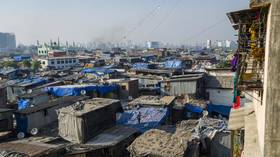Death in the slum: India holds its breath as coronavirus spreads to tightly-packed shanty town

A series of coronavirus deaths in India’s biggest slum has panicked authorities and raised a difficult question: how can the government stop a virulent illness in the most vulnerable of neighborhoods?
The alarm was raised on Wednesday following the death of a 56-year-old man. The man was not a prominent official or local celebrity. Indeed, he was a simple garment seller. But he happened to live in one of Asia’s biggest slums, Dharavi, which houses one million people in little over two square kilometers.
Situated on the outskirts of Mumbai, Dharavi packs nearly five times as many people into each square kilometer than the most densely populated district in New York City. Only in Dharavi, they live ten to a hut, and 80 people share a public toilet.
When a street sweeper fell ill with the virus on Thursday, the authorities took action.
A team of doctors and volunteers descended upon the area, with police in tow. They fanned out and stayed till midnight. Families were isolated. Some 2,500 neighbours were stamped for quarantine. The deceased man’s movements during the last two weeks were retraced with the help of his acquaintances. A list of his contacts was compiled and the people on it alerted. His shop, and some 100 others, including the nearby 330 flats, were cordoned off. Common spaces between the buildings were sprayed with hydrochloric acid. A posse of policemen now guards the area to enforce no violation.
The Unknown Dharavi
The story was picked up by the world’s media, whose headlines referred to Dharavi as a “ticking time bomb.” Unlike many of the world’s slums, this one is not unknown in the West. Dharavi was made famous in 2008’s Oscar-winning ‘Slumdog Millionaire,’ a coming-of-age tale set amid the faeces, open sewers, violence and murder of Dharavi.
The world knows little more about Dharavi. Even most Indians don’t know that half of Mumbai’s waste is recycled in this slum. Few know that, as slums go, Dharavi is a relatively egalitarian one. Homelessness is low, and people of different castes and creeds live together in its narrow alleys and crumbling shacks. Mosques, temples, and churches share boundaries.
A magnet for transient laborers, Dharavi accepts everyone; and in turn supplies Mumbai with an army of faceless workers and helpers.This warren of small factories, pottery, plastic, textile, bakery industries etc, generate an annual turnover of $1 billion, 30% of which is paid as taxes.
And the area is in demand. A 600 sq foot apartment costs half a million dollars in Dharavi.
A breeding ground for infection
But that’s not to say that Dharavi isn’t a potential coronavirus hotspot. It has a long history of epidemics. It was devastated by an 1896 plague which killed half of Mumbai’s population, and recurrent plagues would characterise the area for the next quarter of a century, all with high mortality rates.
Dysentery, cholera, typhoid, leprosy, polio have dropped its residents like flies, with Dharavi’s high population density and poor sanitation hastening their spread. In 1986, a cholera epidemic showed up most of its victims hailing from Dharavi. Those who survive the epidemics aren’t out of the woods either. Fires and floods are recurrent in the slum, and a 2013 inferno gutted more than 800 buildings.
Also on rt.com As India locks itself down over coronavirus, West’s bias factory is working overtimeIndia girds up loins for challenge
Today’s anxiety of the Indian officials is understandable. The government has counted the elders in the locality and put them under extensive testing. Fortunately, the country is now equipped with antibody blood tests which take only 15-30 minutes. India also has an Integrated Disease Surveillance Programme (IDSP) for a decade and half now. Its data allows health authorities to scan cases from the Public Health Care (PHC) level upwards. It can spot clusters of a community outbreak of diseases, and quarantine problem areas.
Indian authorities, for the moment, have identified around a dozen of these hotspots, but Dharavi is not one of them. Nevertheless, the dramatic police response last week suggests that they are doing all they can to prevent it from becoming one. After all, social distancing and self-isolation are all but impossible in such a crowded slum.
"We are talking about a slum where 10-12 people live in 10x10 feet tin hutments. You can't expect them to sit at home all day long," Vinod Shetty, director of a sanitation workers’ non-profit told India’s NDTV. "They pay 25 rupees (33 US cents) for a gallon of water, you'll tell them to wash their hands frequently. Eighty people share a public toilet, you'll tell them to not leave their house. How is that possible?"
"We are a family of five," one resident told AFP. "We use communal toilets or have to get water from public taps. Only God can save us.”
With living conditions on the virus’ side, authorities are no doubt hoping that a strong initial crackdown can save Dharavi from having to weather yet another epidemic.
Outside the slum, more than 4,700 cases of coronavirus have been confirmed in India, and 136 people have died. Worldwide, the virus has infected over 1.3 million people, and claimed more than 74,600 lives.
Like this story? Share it with a friend!
The statements, views and opinions expressed in this column are solely those of the author and do not necessarily represent those of RT.














